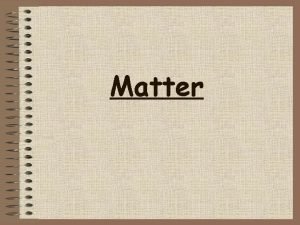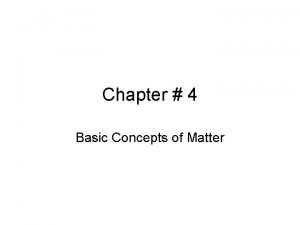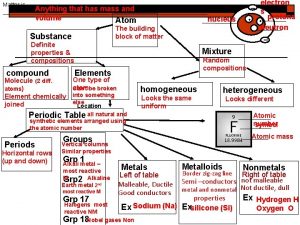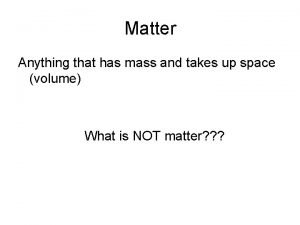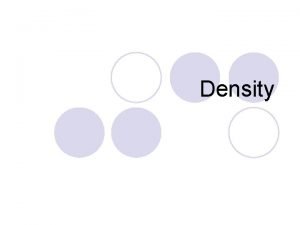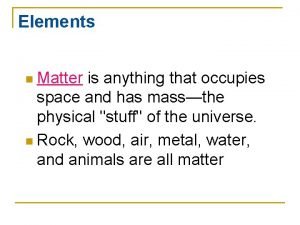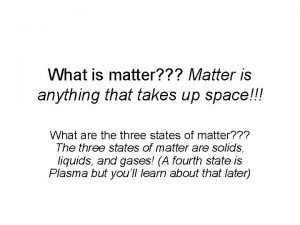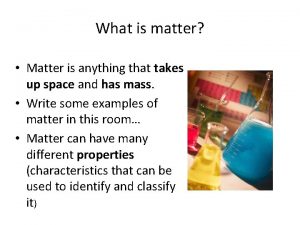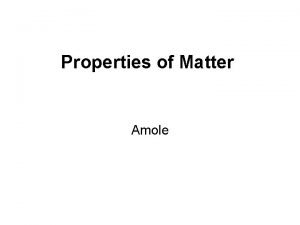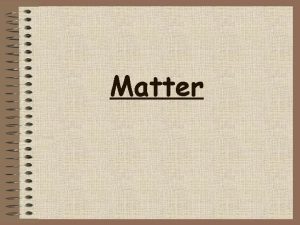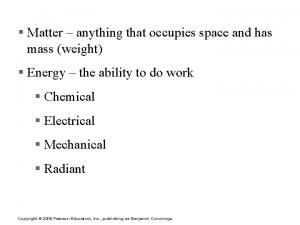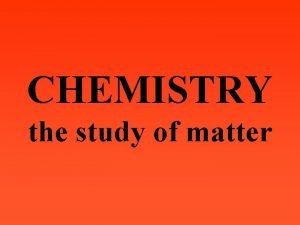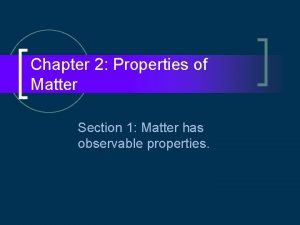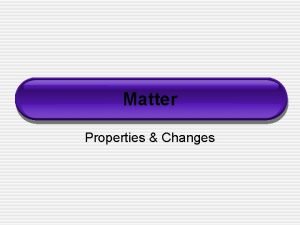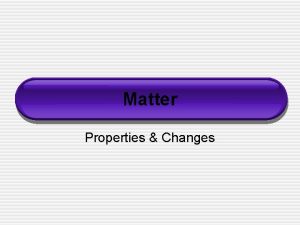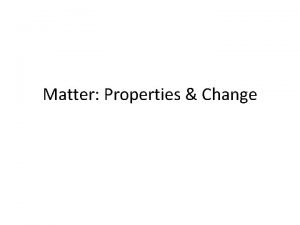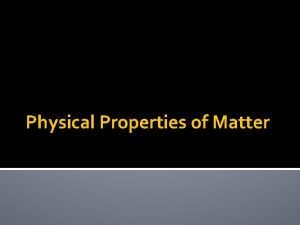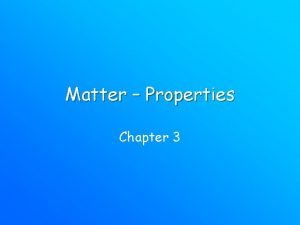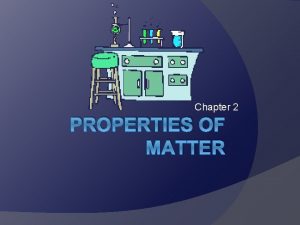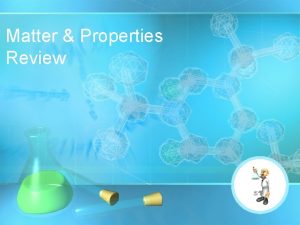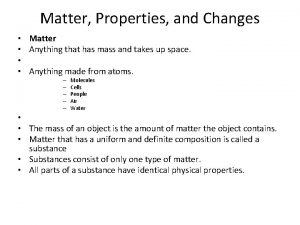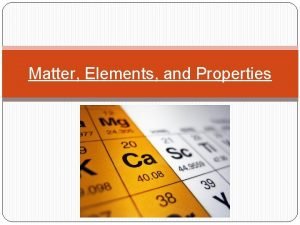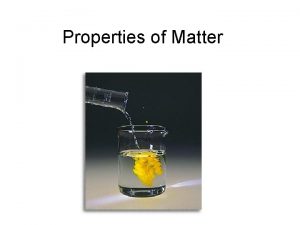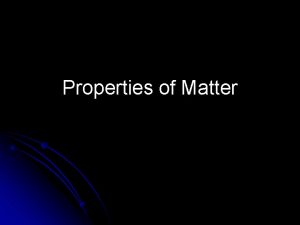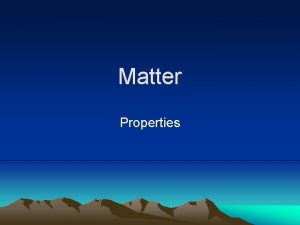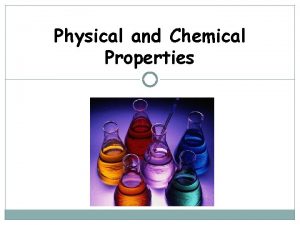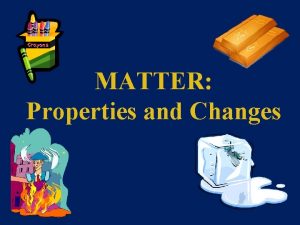Chapter 10 PROPERTIES OF MATTER MATTER Anything which


























- Slides: 26

Chapter 10 PROPERTIES OF MATTER

MATTER � Anything which has mass and occupied space is called Matter. �There are three state of matter. � (i)Solid � (ii) Liquid � (iii) Gas

MOLECULAR THEORY OF SOLID �In solids, the molecules are closely packed due to the strong force of attraction. II. Molecules cannot move freely but they can move to and fro about their mean position. iii. Solids have definite volume and shape due to their force of attraction and very Tiny space between them. iv. It is not easy to compress solid but they broken down.

MOLECULAR THEORY OF LIQUIDS �The liquid molecules can move freely from one place to another place as compared to solids. ii. Liquids have definite volume due to some force of attraction between their molecules, but no definite shape due to weak force of attraction between their molecules. iii. The distance between liquid molecules is larger as converted to solid molecules

MOLECULAR THEORY OF GASES �Gases have no definite shape and volume because of very large distance between their molecules and very least force of attraction between their molecules. ii. The force of attraction can be negligible between gases molecules due to this the gases molecules can freely move from one place to another. iii. The molecules of a gas collide with one another and with the walls of the container and exert pressure on the walls. iv. Gases expand on heating because the kinetic energy of molecules is increased and distance between them is also increased.

Differentiate between solids, Liquids and Gases �SOLIDS: (i) They have definite shape and volume. (ii) The molecule of solids has vibratory motion. (iii) They have greater. density. (iv)The distance between molecules solids is very short LIQUIDS: (i) They have definite volume but not shape. (ii)The molecules of liquids have random motion. (iii)They have low density as compared to solids. (iv)The distance between Molecules of liquids is greater than solids. GASES: (i)They have not definite shape and volume. (ii)The molecules of gas moves in a straight line. (iii)They have very low density as compared to solids and liquids. (iv)The distance between Molecules of gases is much Greater than solids & liquids.

KINETIC MOLECULAR THEORY OF MATTER �According to kinetic theory of matter: �Matter is made of very small particles called MOLECULES. �These molecules are in a state of motion. �They possess Kinetic Energy. �Molecular motion may be translational , rotational or vibrational. �These molecules attract each other. �As the temperature of a substance is increased , its molecular speed is also increased and vice versa. �If a substance is compressed , The K. E of its molecules increases and its temperature rises.

BROWNIAN MOTION �A famous scientist ROBERT BROWN observed that molecules of a substance are moved in ZIG ZAG path. Their motion is random. They collide with each other and move in a new direction after collision in ZIG ZAG fashion. This type of motion present in the molecules of matter is called "Brownian motion".

ELASTICITY �The property of solid by virtue of which a solid body recovers its original shape after the removal of an applied force is called "ELASTICITY".

ELASTIC LIMIT �If applied force on a solid is gradually increased, a state is reached after which the material will not return to it original shape even after the removal of applied force. This limit is called "ELASTIC LIMIT". After elastic limit, material is permanently deformed. Different substances have different elastic limit.

Deformation �If a force is applied on a body to change the shape, then that state is called Deformation. TYPES OF DEFORMATION: Linear Deformation: If a force is applied on a body to change in length, then this state is called Linear deformation. Cubic Deformation: If the volume of a body changes due to applying force, then that state is called Shearing deformation.

STRESS � When a body is deformed, the internal force came into play per unit area to restore it to its original state is called "STRESS" OR "Stress is an opposing force expressed per unit area which resists any change in shape. " � Stress is equal to the force per unit area. Mathematically: Stress produces when a body is made to change in length, volume or Shape by the application of an external force.

UNIT OF STRESS �N/m 2 in S. I. System �Dyne/cm 2 in C. G. S. System.

Types of Stress �There are three types of Stress. i. Linear Stress. ii. Cubic Stress. iii. Surface Stress. 1. Linear Stress: When change in length of a body, due to stress is called Linear Stress. 2. Cubic Stress: When change in length, width and height of a body due to stress is called Cubic Stress. 3. Shearing Stress: When change in surface of a body due to stress is called Shearing stress.

STRAIN � "Strain is the fractional deformation produced in a body when it is subjected to a set of deforming forces. " OR The change in length, volume or shape due to the application of a deforming force is called "Strain". OR "The fractional Deformation due to stress is called STRAIN. " � Strain has no unit because it is a ratio of two similar physical quantities.

LONGITUDINAL STRAIN � "The change in length per unit length of a body due to a deforming force is called LONGITUDINAL STRAIN" � For latest information , free computer courses and high impact notes visit : www. citycollegiate. com � Mathematically: HOOK'S LA Hook¢s law is a quantitative relation between stress and strain. W STATEMENT Hook's law states: "Within elastic limit , strain produced in a body is directly proportional to stress" i. e. Strain µ Stress OR Strain =(Constant)(Stress) Where 1/K = constant of proportionality Strain =(1/K)(Stress) OR Stress / Strain = K With the help of above equation Hook¢s law can also be stated as :

YOUNG'S MODULUS � "The ratio of stress to the longitudinal strain is called Young's modulus. " � Young's Modulus = Stress / Longitudinal Strain � OR � Y = s / e. . (i) � But s = F / A and e = DL / L � Putting these values in equation (i) � Y =( F / A) / (DL / L) OR Y = F L / A DL � In S. I. system unit of ‘Young's Modulus is N/m 2

Characteristics of Stationary Liquids �The pressure exerted by the liquid acts perpendicular to the walls of vessel in which it is kept. ii. Pressure exerted on the liquid is transmitted equally in all directions. iii. In liquids, the pressure at the same depth is equal in all directions.

Pressure �The perpendicular force acting on the unit area of a body is called Pressure. Explain: i. If we push a drawing pin with a sharp pointed tip into a piece of wood. It will penetrate the wood. ii. Under the tip of the drawing pin the force is very high on the small area of the tip of the pin. Hence it penetrates into the wood. iii. Now it is difficult to cut things with a blunt knife because the area of the blunt edge of the knife is relatively more and the force over this area is less as compared to the sharp edge. Mathematically: Pressure = Force / Area P = F / A

PRESSURE OF LIQUIDS: �Water contained in a glass has weighed. As the weight is a force what acts downward, therefore the water exerts a pressure on the bottom of the glass. Similarly, every liquid exerts force per unit area of container, which is called Pressure of Liquids depends upon following factors: i. Density of Liquid: If a liquid more dense then pressure is more. ii. Depth of Liquid: If the depth of liquid is greater than the pressure is greater.

that the pressure of liquids depends upon density and depth or P = phg � Suppose water contained in a gas, exerts force per unit area is called Pressure. If “F” is force, “A” is area and Pressure is “P” then. P = F / A ________1 We know that F = mg ________2 Mass per unit volume is called Density and it is denoted by (RHU) OR “p “ P = m / V m = Pv The volume is, V = Length x Width x Height V = L x W x h V = A x h So, m = P (A x h) put in equation – No. 2 F = mg F = P (A x h) g Now put the value of “F” in equation No. 1 P = phg Where “p” is density, h = depth, g = acceleration due to gravity. Hence it proved the pressure of liquid depends upon depth and density.

ARCHIMEDES PRINCIPLE � � � According to Archimedes principle: "When a body is immersed in a liquid, it loses its weight or an upward thrust acts upon it which is equal to the weight of an equal volume of the liquid displaced. " PROOF OF ARCHIMEDES PRINCIPLE Consider a cylinder of length 'L' and area of cross-section 'A' immersed in a liquid of density 'r. Let the depth at point a = h 1 the depth at point b = h 2 Now, Pressure at point a and b is Pa = rgh 1 , Pb = rgh 2 We know that [Thrust = P. A ] Thrust at point a = rgh 1 A Thrust at point b = rgh 2 A Net thrust = rgh 2 A - rgh 1 A Net thrust = rg. A(h 2 - h 1) [ But from figure h 2 - h 1= L ] There fore , Net thrust = rg. AL Net thrust = rg. V Net thrust = (r. V)g Net thrust = mg Net thrust = W Net thrust = weight of liquid displaced. This shows that upward thrust on the cylinder is equal to the weight of liquid displaced.

RESULTS OF ARCHIMEDES PRINCIPLE �With the help of Archimedes principle we conclude that: (1) A body will float over a liquid if displaces liquid whose weight is greater than the weight of body. (2) A body will sink in a liquid if it displaces liquid whose weight is less than the weight of body.

Scientific Reason �A huge ship floats over water but a small nail sinks into water. Explain why ? Answer : Floating of a huge ship or sinking of a nail is according to Archimedes principle. A huge ship displaces water whose weight is greater than the weight of ship & the upward thrust on the ship balances its weight. That's why ship floats over water surface. On the other hand nail displaces water whose weight is less than the weight of the nail. Due to this reason nail sinks into water.

Principle of Pascal � According to this principle, if a pressure is applied to a liquid contained in a vessel, it is transmitted pressure equally in all direction and acts perpendicularly to the walls of the container. This was discovered by Blaise Pascal, and is known as Pascal’s Principle. Explanation: It is explain with the help of following experiment. Experiment: i. Take a vessel which is connected with four Similar pistons. ii. Fill it with water. iii. Apply a force to one end of the pistons. iv. The other three pistons simultaneously move through small distance outwards. v. Thus it can be proved that the pressure has been transmitted in all directions throughout the water.

TYPES OF HYDRAULIC MACHINES �There are three types of Hydraulic Machines. i. Hydraulic Break system. ii. Hydraulic Lifts. iii. Hydraulic Press.
 Matter is anything that has
Matter is anything that has Matter anything that
Matter anything that Anything that has mass and takes up space is
Anything that has mass and takes up space is Something that has mass and occupies space
Something that has mass and occupies space Matter is defined as anything that
Matter is defined as anything that What is anything that has mass and volume
What is anything that has mass and volume Something that takes up space
Something that takes up space What are the 7 diatomic elements
What are the 7 diatomic elements Matter is anything that has and occupies
Matter is anything that has and occupies All matter has and takes up
All matter has and takes up Matter anything that
Matter anything that Matter is anything that...
Matter is anything that... Matter is anything that has both
Matter is anything that has both Matter is anything that occupies space and has
Matter is anything that occupies space and has Ionized matter
Ionized matter What is matter
What is matter No matter anything
No matter anything Matter is anything that
Matter is anything that Matter vs mass
Matter vs mass Masses defintion
Masses defintion Matter anything that
Matter anything that Matter anything that
Matter anything that Matter anything that
Matter anything that Matter anything that
Matter anything that Section 2 properties of matter
Section 2 properties of matter Chapter 2 properties of matter answer key
Chapter 2 properties of matter answer key Chapter 2 section 1 classifying matter answer key
Chapter 2 section 1 classifying matter answer key

